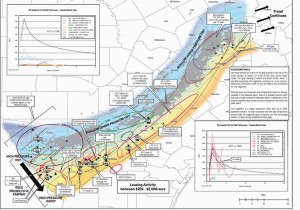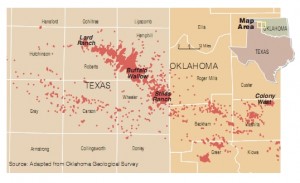Apr
26
Don’t Mess With Texas Oil & Gas
April 26, 2010 | 13 Comments
The past week saw a flurry of reports and commentary about the Texas petroleum formation called Eagle Ford. Eagle Ford is a huge new oil and gas discovery, well, maybe not ‘new’ as much as economically profitable with the technology of horizontal drilling and hydraulic fracturing. With no particular surprise the technology has migrated from gas production areas to oil and liquid condensate production.
It’s the liquids that have so many noticing. Methane and some ethane are the principle components of natural gas. Ethane is usually taken out in part or wholly removed to use in chemical processes. They are both gasses at reasonable pressures. The ‘liquids’ start with propane, a liquid at comfortable, low technology pressures. A three carbon atom petroleum molecule at moderate pressure is liquid, thus the name ‘Liquid Petroleum Gas” or LPG.
Propane is often made by fracturing larger petroleum molecules from oil products. That’s the key, the liquids starting with propane are much more expensive than the natural gas products and command better prices. The four carbon atom butane common in pocket lighters, five carbon atom pentane, six carbon atom hexane and the seven carbon atom heptane all have large well developed markets. At the five carbon atom molecule to seven, the liquids stay that way at atmospheric pressure, even though they vaporize rapidly, are called natural gas condensate or sometimes called natural gasoline or simply as condensate. Flowing directly from the well instead of having to be refined out or made from oil makes these products valuable.
With natural gas prices way down and cheap compared to oil, sometimes as low as 1/20th as much per Btu as crude oil, the expensive well drilling and completion technologies have a new way to stay busy and support energy supplies. It’s difficult to imagine a better time than now for the Eagle Ford and the Granite Wash areas to be rediscovered.
Eagle Ford is proving to be rich in condensate. More information about the size of the field and the volumes of condensate and gas is coming out almost every day now, and the numbers are getting better and better. Only a year ago a dozen drilling rigs were working across the entire area that stretches across more than 30 Texas counties. Today, more than 50 rigs are drilling well after well.
Those 50 drilling rigs should allow production to grow to nearly 40,000 barrels of oil equivalent per day within the next 24 months. That’s roughly $1 billion worth of oil per year at current prices. Keep in mind; this is just from the handful of rigs working in Eagle Ford during 2009. The estimates don’t include the value of the natural gas that will also be produced.
New seismic technologies are being employed to find liquid hydrocarbons, even though the wells are deep and the productive regions narrow. Eagle Ford wells are drilled about 12,000 feet down and Granite Wash starts at 13,000 on to 17,000 feet, with the productive zone usually only a few hundred feet thick. To efficiently drill these wells requires horizontal drilling, where rigs first must bore down to the oilfield and then veer sideways through it.
The combination of these new technologies is releasing huge amounts of liquid hydrocarbons in the Eagle Ford and newly active Granite Wash area in North Texas.
Penn Virginia, a U.S. publicly traded exploration firm disclosed during its first quarter operational update that it has drilled 18 gross wells so far in the Granite Wash. Its average initial production rate is 10.1 MMcfe per day, and it has reduced its well cost to $6.3 million each.
The Granite Wash area spans 2,000 square miles across parts of the Texas Panhandle and western Oklahoma. Some of the Granite Wash wells drilled thus far have shown up to a 30%-plus liquids component of the production stream, which at current crude prices makes for significantly improved economics. The Granite Wash area is very low risk due to substantial sub-surface information, efficient to market because significant transportation and services infrastructure already exist in the area.
Granite Wash is a significant boon to North Texas. As big as it is, its tiny compared to Eagle Ford.
The Eagle Ford shale trends across a great swath of Texas, stretching from the Giddings Field in Brazos and Grimes counties down southwest into the Maverick Basin in Maverick County at the border with Mexico. The field is huge. The Eagle Ford was formed during the Cretaceous period has long been known as a “majestic source rock”, meaning the petroleum has been seeping up into easier to access zones supplying hydrocarbons to the great Austin Chalk fields and the famed giant East Texas Field for tens of millions of years.
Now it’s becoming productive as an impressive self-sourced reservoir.
Some folks are already calling the Eagle Ford area the sixth largest domestic oil discovery in U.S. history. The shale found there has higher natural porosity and permeability than other shale formations.
It used to be a problem when drilling through it for deeper oil.
The Eagle Ford has another interesting aspect. Its been drilled through aplenty with well bores available that could possibly be re-entered and drilled horizontally at much reduced cost.
In one news release a well was drilled to 11,300 feet with a horizontal lateral over 3200 feet. The operator managed to pack over two million pounds of sand in ten stages. The Eagle Ford shale is high in carbonate content, making it very brittle and therefore able to be easily hydraulically fractured. Its little wonder the field is prolific.
The infrastructure is already there, too.
While not every well that’s drilled will be productive, in shale exploration like this one the odds are much better. Unlike the relatively small fields and pockets of oil and gas that exploration companies have chased over the years, this field is huge, underneath a very wide swath of Texas, all the way from Southeast Texas to Mexico. The mainstream media has not yet reported the full implications of this massive oil and gas field, but it will be major news very soon.
This is good for Texas and all of the U.S.
Comments
13 Comments so far




[…] Don’t Mess With Texas Oil & Gas | New Energy and Fuel […]
[…] Don't Mess With Texas Oil & Gas | New Energy and Fuel […]
[…] Don't Mess With Texas Oil & Gas | New Energy and Fuel […]
[…] Don't Mess With Texas Oil & Gas | New Energy and Fuel […]
My late brother was a directional driller.
He told me that oil is not in giant underground lakes but rather in tubes or fingers.
With horizontal or directional drilling you have the ability to drill around and hit several of those tubes that the old straight down drillers never found.
Terrific work! This is the type of information that should be shared around the web. Shame on the search engines for not positioning this post higher!
found your site on del.icio.us today and really liked it.. i bookmarked it and will be back to check it out some more later
I was just having a conversation over this I am glad I came across this it cleared some of the questions I had.
I’ve just started off a blog, the knowledge you give on this site has aided me extremely. Thank you for all your time & work.
This post makes a lot of sense !
Awesome post. I so good to see someone taking the time to share this information
It amazes me that one billion dollars worth of oil can be drilled by only fifty rigs in one year. This is a very impressive number. It also amazes me that the holes are drilled 13,000 feet. Oil drilling is something that I am beginning to be really interested in. Thanks for sharing.
Oil and gas jobs are and always have been a flourishing profession. The petroleum industry is booming and there is a constant ongoing worker shortage. Despite the demand for workers, it takes more than a list of addresses and phone numbers to land an oil and gas job. It not only takes having in-depth industry knowledge and a proven strategy; you will also need to have an understanding of the oil and gas industry’s insider tips.